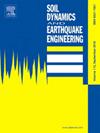Absorbing boundary conditions in material point method adopting perfectly matched layer theory
IF 4.2
2区 工程技术
Q1 ENGINEERING, GEOLOGICAL
引用次数: 0
Abstract
This study focuses on solving the numerical challenges of imposing absorbing boundary conditions for dynamic simulations in the material point method (MPM). To attenuate elastic waves leaving the computational domain, the current work integrates the Perfectly Matched Layer (PML) theory into the implicit MPM framework. The proposed approach introduces absorbing particles surrounding the computational domain that efficiently absorb outgoing waves and reduce reflections, allowing for accurate modeling of wave propagation and its further impact on geotechnical slope stability analysis. The study also includes several benchmark tests to validate the effectiveness of the proposed method, such as several types of impulse loading and symmetric and asymmetric base shaking. The conducted numerical tests also demonstrate the ability to handle large deformation problems, including the failure of elasto-plastic soils under gravity and dynamic excitations. The findings extend the capability of MPM in simulating continuous analysis of earthquake-induced landslides, from shaking to failure.
求助全文
约1分钟内获得全文
求助全文
来源期刊

Soil Dynamics and Earthquake Engineering
工程技术-地球科学综合
CiteScore
7.50
自引率
15.00%
发文量
446
审稿时长
8 months
期刊介绍:
The journal aims to encourage and enhance the role of mechanics and other disciplines as they relate to earthquake engineering by providing opportunities for the publication of the work of applied mathematicians, engineers and other applied scientists involved in solving problems closely related to the field of earthquake engineering and geotechnical earthquake engineering.
Emphasis is placed on new concepts and techniques, but case histories will also be published if they enhance the presentation and understanding of new technical concepts.
 求助内容:
求助内容: 应助结果提醒方式:
应助结果提醒方式:


